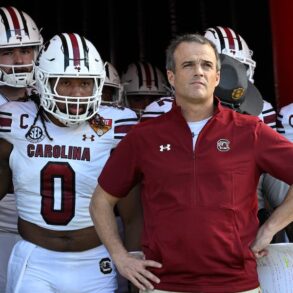
When college sports’ most recent round of football-driven conference realignment began more than three years ago, it came with a promise of more blockbuster games, higher TV ratings and new, fresh rivalries.
What no one seemed to fully appreciate at the time was that the expanding conferences, along with the scrapping of divisions, had created major problems for their standings and championship game races. Now college football is careening toward a potential tiebreaker nightmare in November. The uncertainty and closeness of bloated conference races will be a lot of fun, until it’s a problem.
Advertisement
Clemson, Miami (Fla.) and SMU are all at least 7-1 overall, undefeated in ACC play and not scheduled to play each other. In the Big Ten, Oregon, Penn State and Indiana are all undefeated and don’t play each other. The SEC has five teams with one or zero conference losses, and the Big 12 has four. Not everyone in those two logjams plays each other.
It might work itself out in the end. But the possibility that it doesn’t is very real. How could a conference defend itself if a team undefeated in league play didn’t make its title game? Whether undefeated or not, it’s likely some tiebreaking scenario is going to upset one or more fan bases. Especially because those conference championships determine which four teams earn first-round byes in the 12-team College Football Playoff, this situation doesn’t feel tenable in the long term.
It’s basic math that an 18-team conference in which members only play nine conference games makes little sense. Same goes for a 16-team conference that plays eight conference games. Too many teams don’t play each other over the course of a season, leaving the conference championship game hopefuls exposed to the luck of the scheduling draw. There’s a reason we haven’t had conferences this big in 90 years, since the 23-team Southern Conference split up into the SEC.
Hard as conferences may try to use historical performance and analytics to make schedules even, you never know when a bottom-feeder like Indiana will rise up as an unexpected 8-0 team, or a big brand like Florida State will start 1-7, suddenly turning even schedules into very uneven paths with matchup holes and massive consequences.
The SEC has announced its tiebreaking process with 16 teams and no divisions.
I hope we get to the random draw stage. pic.twitter.com/YaT8jOweN5
— Chris Vannini (@ChrisVannini) August 21, 2024
College football used to have conferences in which each member played almost everyone. Then they got bigger and added divisions. Tiebreakers, when needed, were simple. There were some one-off controversies, like in 2008 when the Bowl Championship Series rankings decided a three-way deadlock in the Big 12 South as the fifth tiebreaker, but they were rare.
Advertisement
Then college football conferences, in getting even bigger, decided to scrap divisions. Why? Teams had stopped playing each other. Texas A&M joined the SEC in 2012, yet Georgia has played Texas A&M just once and still hasn’t visited College Station. Over 12 years, the SEC couldn’t find space in its eight-game schedule.
Leagues haven’t added more conference games in the wake of their latest rounds of expansion, either because schools still want their seven home games (which for some include coveted easy nonconference wins), or because broadcasters won’t yet pay for more inventory.
To this point, the conference races have been incredibly close and fun. But the football season is such a small sample that the chances of a mess at the end are high. The Mountain West played its first season without divisions last year and had to wait until the Sunday after the regular season to figure out who would play in the conference title game. Boise State, UNLV and San Jose State all finished 6-2, and Boise State and UNLV hadn’t played each other. The tiebreaker went to an average of four computer rankings and produced a Boise State-UNLV matchup, even though San Jose State had beaten UNLV a day earlier.
While the Mountain West tiebreakers were unique, this type of thing could become a regular occurrence, and fans may not all realize it yet. The SEC didn’t announce its tiebreaker plans until late August. The Big 12’s didn’t come out until early September, after the season began. The MAC’s came out in mid-September. It might’ve been wise to get out far ahead of this and educate fans.
We’ll never get to the coin flip or random drawing every conference had to include at the bottom of its tiebreaker list, as if it were a scene from “Friday Night Lights”. But that might be easier to understand than comparing the tied teams’ records against common opponents, which is the SEC’s second tiebreaker. Heck, the Big Ten in 1973 had its athletic directors vote on sending Ohio State or Michigan to the Rose Bowl. Talk about made-for-TV drama.
Advertisement
Expanding for the sake of TV money, or expanding for the sake of survival, has left us with oversized conferences, some of which go coast-to-coast. We’ve experienced that in the kickoff times. But we haven’t yet experienced how these currently crowded races could end with everyone holding up tiebreaker decision trees at the finish line.
One year after undefeated Florida State was left out of the CFP, the potential for a different kind of chaotic and controversial finish to the regular season in several conferences is very much on the table.
(Photo: Tom Hauck / Getty Images)
This post was originally published on this site be sure to check out more of their content.







